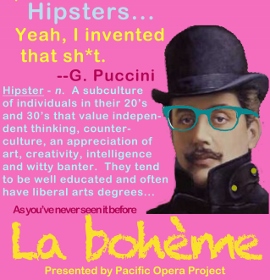HIPSTER OPERA
LA Opera should take note of Pacific Opera Project. The upstart company’s edgy productions explode popular perceptions of what opera is and how it should be performed. Pacific Opera Project takes this typically elite art form and strips it down to its barest essentials: stunning music and simple, enjoyable stories. Its latest production, a hipster-inspired version of Giacomo Puccini’s La Bohème, has almost 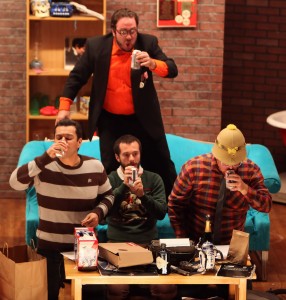 a cabaret feel, as there are no fixed rows of seats. Instead, dozens of tables have been erected in front of the stage set with a bottle of red or white wine and a platter of cheese, charcuterie, and other nibbles. While standard row seats are available in the back for $20, it is definitely worth shelling out $60 or $100 for a table for two or four.
a cabaret feel, as there are no fixed rows of seats. Instead, dozens of tables have been erected in front of the stage set with a bottle of red or white wine and a platter of cheese, charcuterie, and other nibbles. While standard row seats are available in the back for $20, it is definitely worth shelling out $60 or $100 for a table for two or four.
Pacific Opera Project put together La Bohème in less than a week, which is one reason why it’s being described as a pop-up opera (it also happens to be running for one weekend only). When introducing the show on opening night, director and designer Josh Shaw said that it certainly helped having the production in his own neighborhood. And it is obvious from the marketing and supertitle translations that Shaw is aiming to draw in Highland Park hipsters. His transformation of La Bohème into an opera about hipsters couldn’t be more apt. After all, the hipsters of today are basically equivalent to the bohemians of yesterday.
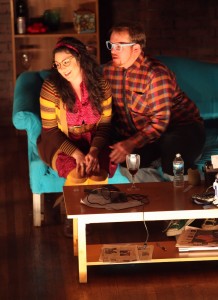 The opera’s libretto, written by Luigi Illica and Giuseppe Giacosa, is based on Henri Murger’s 1851 collection of short stories, Scènes de la vie de bohème. Portraying the lives of young bohemians living in Paris’ Latin Quarter during the reign of King Louis Philippe (1830-1848), the opera focuses on Rodolfo and Mimi. The story of their relationship is spun out over four acts, beginning with how the two meet and ending with Mimi’s death. A secondary plot concerns Rodolfo’s roommate Marcello and his relationship with Musetta. Jealousy and poverty are both strong themes in the relationship dynamics of the story’s principal characters.
The opera’s libretto, written by Luigi Illica and Giuseppe Giacosa, is based on Henri Murger’s 1851 collection of short stories, Scènes de la vie de bohème. Portraying the lives of young bohemians living in Paris’ Latin Quarter during the reign of King Louis Philippe (1830-1848), the opera focuses on Rodolfo and Mimi. The story of their relationship is spun out over four acts, beginning with how the two meet and ending with Mimi’s death. A secondary plot concerns Rodolfo’s roommate Marcello and his relationship with Musetta. Jealousy and poverty are both strong themes in the relationship dynamics of the story’s principal characters.
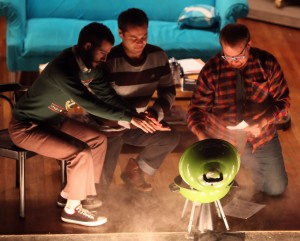 Whereas Puccini’s opera includes ten roles and instrumentation for full orchestra, Pacific Opera Project makes do with seven singers and piano accompaniment. Stephen Karr, who has conducted the orchestra on previous productions, here conducts and accompanies. While the orchestration is definitely missed, the lack thereof certainly shortens the production to a more manageable length, decreases ticket costs and facilitates the audience’s closer proximity to the stage. The simple piano accompaniment also puts forward the cast’s impressive vocal performances more prominently and with less distraction.
Whereas Puccini’s opera includes ten roles and instrumentation for full orchestra, Pacific Opera Project makes do with seven singers and piano accompaniment. Stephen Karr, who has conducted the orchestra on previous productions, here conducts and accompanies. While the orchestration is definitely missed, the lack thereof certainly shortens the production to a more manageable length, decreases ticket costs and facilitates the audience’s closer proximity to the stage. The simple piano accompaniment also puts forward the cast’s impressive vocal performances more prominently and with less distraction.
Neither is a chorus of supporting roles necessary; when most or all of the seven singers join together in song, the volume of sound is more than adequate, if not overwhelming. And each individually puts in a strong vocal and dramatic 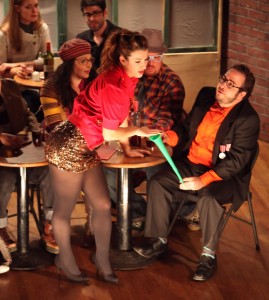 performance; there is not a single weak link in the entire cast. Daria Somers, who shined as Fiordiligi in Pacific Opera Project’s Cosi Fan Tutte, similarly shines as Mimi in La Bohème. Perhaps because of costuming, her role comes across as understated in its dramatic power. Instead, the other female role (Musetta) played by Katherine Giaquinto, is far more memorable, since the latter plays the role of seductress with great gusto and glamor. Yet there is beauty in Somers’ understated presence, especially in her coy rendition of “Si, mi chiamano Mimi” (“Yes, they call me Mimi”). The real star of the show, however, is Clay Hilley as Rodolfo. His sumptuous tenor voice animates nearly every scene of the opera and blends well with Somer’s soprano on such duets as “O soave fanciulla” (“Oh lovely girl”). And while Adam Meza as Marcello is not nearly so prominent as Hilley, his warm, rich baritone is recording-studio perfect.
performance; there is not a single weak link in the entire cast. Daria Somers, who shined as Fiordiligi in Pacific Opera Project’s Cosi Fan Tutte, similarly shines as Mimi in La Bohème. Perhaps because of costuming, her role comes across as understated in its dramatic power. Instead, the other female role (Musetta) played by Katherine Giaquinto, is far more memorable, since the latter plays the role of seductress with great gusto and glamor. Yet there is beauty in Somers’ understated presence, especially in her coy rendition of “Si, mi chiamano Mimi” (“Yes, they call me Mimi”). The real star of the show, however, is Clay Hilley as Rodolfo. His sumptuous tenor voice animates nearly every scene of the opera and blends well with Somer’s soprano on such duets as “O soave fanciulla” (“Oh lovely girl”). And while Adam Meza as Marcello is not nearly so prominent as Hilley, his warm, rich baritone is recording-studio perfect.
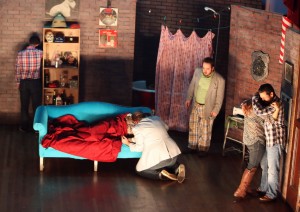 Especially in the opera’s first two acts, La Bohème‘s talented cast is able to milk the story for laughs and gags. These include a futile attempt to heat Rodolfo’s apartment with a small barbecue grill and Musetta’s dramatic entrance accompanied by armfuls of designer shopping bags. While the cast has plenty of comic talent, the majority of humor is provided by the super-titles that translate the libretto’s original Italian into contemporary English, often of a very colloquial and colorful variety. Character names are not changed, but place names are. Thus, Act Two takes place at the York Cafe and Act Three near Big Bear. During the cafe scene, the super-titles even show screenshots of text messages exchanged between the characters.
Especially in the opera’s first two acts, La Bohème‘s talented cast is able to milk the story for laughs and gags. These include a futile attempt to heat Rodolfo’s apartment with a small barbecue grill and Musetta’s dramatic entrance accompanied by armfuls of designer shopping bags. While the cast has plenty of comic talent, the majority of humor is provided by the super-titles that translate the libretto’s original Italian into contemporary English, often of a very colloquial and colorful variety. Character names are not changed, but place names are. Thus, Act Two takes place at the York Cafe and Act Three near Big Bear. During the cafe scene, the super-titles even show screenshots of text messages exchanged between the characters.
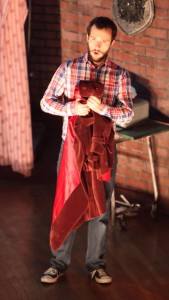 Josh Shaw and Stephen Karr have once again put together a fantastic operatic production showcasing some of the finest vocal talent available at an extremely affordable price. Under Shaw’s creative direction at the Highland Park Ebell Club, La Bohème has been superbly brought to life in a setting that is faithful to the original, as well as intimately and creatively wrought. From the colorful thrift store costumes and hipster vibe to the cast’s emotive singing and enthusiastic performances, it is a production that sparkles with wit and infectious joie de vivre. I can’t wait to see what Pacific Opera Project will present next!
Josh Shaw and Stephen Karr have once again put together a fantastic operatic production showcasing some of the finest vocal talent available at an extremely affordable price. Under Shaw’s creative direction at the Highland Park Ebell Club, La Bohème has been superbly brought to life in a setting that is faithful to the original, as well as intimately and creatively wrought. From the colorful thrift store costumes and hipster vibe to the cast’s emotive singing and enthusiastic performances, it is a production that sparkles with wit and infectious joie de vivre. I can’t wait to see what Pacific Opera Project will present next!
photos by Robert Arce
La Bohème
Pacific Opera Project at Highland Park Ebell Club
played November 9 – 11, 2012
for future shows, visit http://www.pacificoperaproject.com

